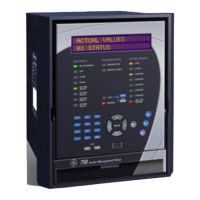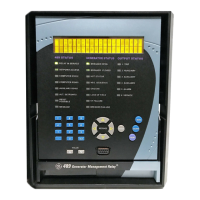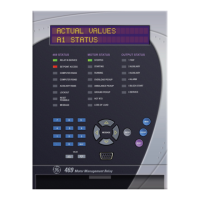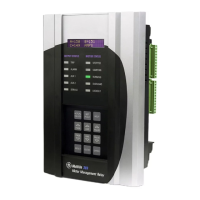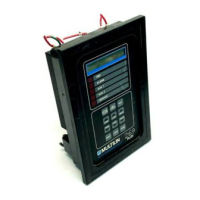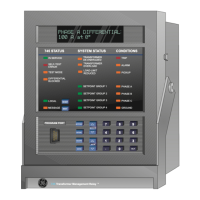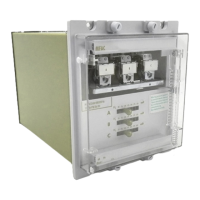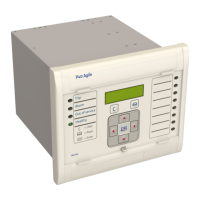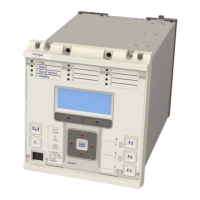S4 Elements745
Transformer Management Relay
Setpoints
http://www.GEindustrial.com/multilin
5–46
GE Multilin
Over and above the standard harmonic inhibit feature programmed above, the 745
contains a harmonic inhibit feature which is in service only during energization and/
or sympathetic inrush. De-energization and energization of the transformer is
detected by any of the following three methods:
1. With energization sensing by current enabled, all currents dropping below the
minimum energization current indicates de-energization; any current exceeding
the minimum energization current indicates energization. This method is the
least reliable method of detecting energization, since an energized and
unloaded transformer will be detected as being de-energized if this method is
used alone.
2. With energization sensing by voltage enabled, the voltage dropping below the
minimum energization voltage indicates de-energization; any current exceeding
the minimum energization current indicates energization.
3. With ‘b’ auxiliary contacts from all switching devices (which can be used to
energize the transformer) connected in series to a logic input and assigned to
the
BREAKERS ARE OPEN setpoint, the contacts closed indicates de-energization;
any current exceeding the minimum energization current indicates energization.
Energization inhibit settings are put in service upon detection of de-energization.
Upon energization, the energization inhibit duration timer is initiated and the
settings are removed from service when the time delay elapses. The energization
inhibit feature may also be put in service during sympathetic inrush. The onset of
sympathetic inrush is detected via a close command to the parallel transformer
switching device connected to a logic input, assigned to the
PARALL XFMR BRKR CLS
setpoint. Energization inhibit settings are put in service when the contact closes.
Upon signal removal, the energization inhibit duration timer is initiated and the
settings are removed from service when the time delay elapses.
In a breaker-and-a-half scheme, where current can be present in the CTs without
being present in the transformer winding, it may be necessary to use the Parallel
Transformer Breaker Close contact to initiate Energization Inhibit.
• ENERGIZATION INHIBIT PARAMETERS: Select “2nd” to compare the 2
nd
harmonic current against HARMONIC INHIBIT LEVEL. Select “2nd + 5th” to use the
RMS sum of the 2
nd
and 5
th
harmonics.
• HARMONIC AVERAGING: Select “Enabled” to use the three-phase average of
the harmonic current against the harmonic inhibit setting.
• ENERGIZATION INHIBIT LEVEL: Enter the level of harmonic current (2
nd
or
2
nd
+ 5
th
) above which the percent differential element is inhibited from
operating. This setting will often need to be set significantly lower than the
HARMONIC INHIBIT LEVEL, especially when used with the “Parallel Xfmr BkrCls”
logic input function for sympathetic inrush.
• ENERGIZATION INHIBIT DURATION: Enter the time delay from the
moment of energization (or the end of the parallel breaker close command)
before the energization inhibit feature is removed from service.
• ENERGIZATION SENSING BY CURRENT: Select “Enabled” to detect de-
energization by the level of all currents dropping below the minimum
energization current.
• MINIMUM ENERGIZATION CURRENT: Enter the current level below which
the transformer is considered de-energized (energization sensing by current
enabled), and above which the transformer is considered energized (any
energization sensing enabled).
• ENERGIZATION SENSING BY VOLTAGE: Select “Enabled” to detect de-
energization by the level of the voltage dropping below the minimum
energization voltage. This setpoint is displayed only if
S2 SYSTEM SETUP !"
VOLTAGE INPUT ! VOLTAGE SENSING is “Enabled”.
• MINIMUM ENERGIZATION VOLTAGE: Enter the voltage level below which
the transformer is considered de-energized (when
ENERGIZATION SENSING BY
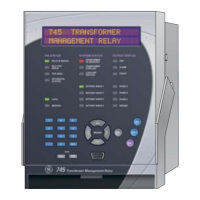
